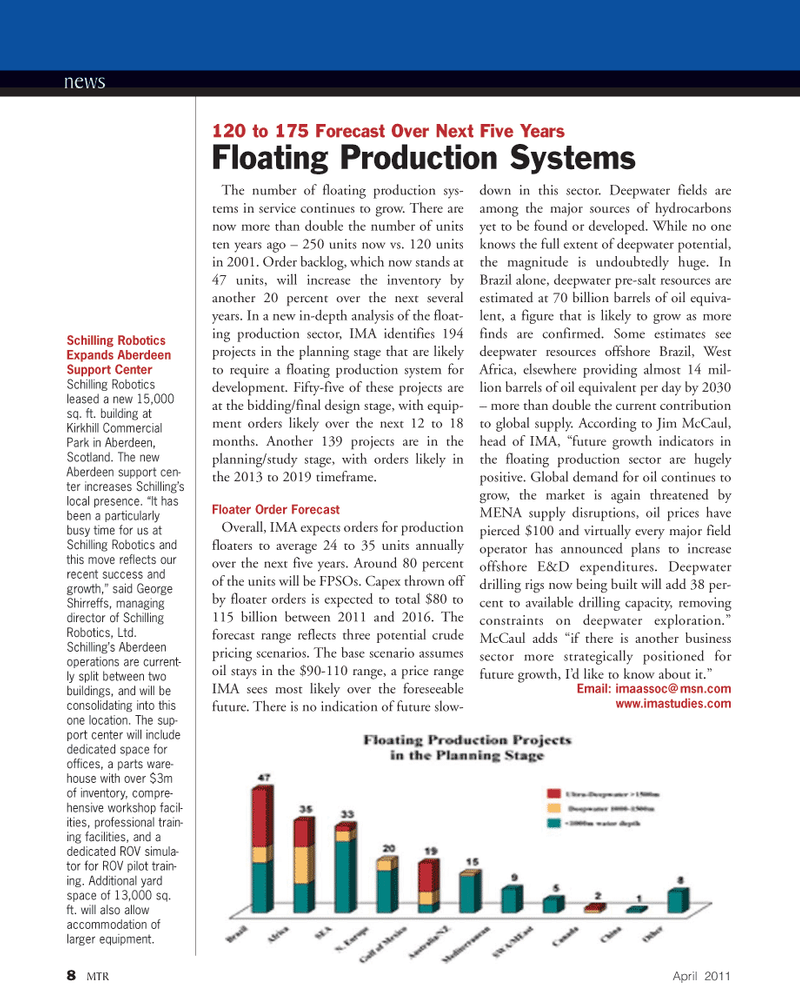
Page 8: of Marine Technology Magazine (April 2011)
Oil & Gas SubSea Monitoring
Read this page in Pdf, Flash or Html5 edition of April 2011 Marine Technology Magazine
news
Schilling Robotics
Expands Aberdeen
Support Center
Schilling Robotics leased a new 15,000 sq. ft. building at
Kirkhill Commercial
Park in Aberdeen,
Scotland. The new
Aberdeen support cen- ter increases Schilling’s local presence. “It has been a particularly busy time for us at
Schilling Robotics and this move reflects our recent success and growth,” said George
Shirreffs, managing director of Schilling
Robotics, Ltd.
Schilling’s Aberdeen operations are current- ly split between two buildings, and will be consolidating into this one location. The sup- port center will include dedicated space for offices, a parts ware- house with over $3m of inventory, compre- hensive workshop facil- ities, professional train- ing facilities, and a dedicated ROV simula- tor for ROV pilot train- ing. Additional yard space of 13,000 sq. ft. will also allow accommodation of larger equipment.
The number of floating production sys- tems in service continues to grow. There are now more than double the number of units ten years ago – 250 units now vs. 120 units in 2001. Order backlog, which now stands at 47 units, will increase the inventory by another 20 percent over the next several years. In a new in-depth analysis of the float- ing production sector, IMA identifies 194 projects in the planning stage that are likely to require a floating production system for development. Fifty-five of these projects are at the bidding/final design stage, with equip- ment orders likely over the next 12 to 18 months. Another 139 projects are in the planning/study stage, with orders likely in the 2013 to 2019 timeframe.
Floater Order Forecast
Overall, IMA expects orders for production floaters to average 24 to 35 units annually over the next five years. Around 80 percent of the units will be FPSOs. Capex thrown off by floater orders is expected to total $80 to 115 billion between 2011 and 2016. The forecast range reflects three potential crude pricing scenarios. The base scenario assumes oil stays in the $90-110 range, a price range
IMA sees most likely over the foreseeable future. There is no indication of future slow- down in this sector. Deepwater fields are among the major sources of hydrocarbons yet to be found or developed. While no one knows the full extent of deepwater potential, the magnitude is undoubtedly huge. In
Brazil alone, deepwater pre-salt resources are estimated at 70 billion barrels of oil equiva- lent, a figure that is likely to grow as more finds are confirmed. Some estimates see deepwater resources offshore Brazil, West
Africa, elsewhere providing almost 14 mil- lion barrels of oil equivalent per day by 2030 – more than double the current contribution to global supply. According to Jim McCaul, head of IMA, “future growth indicators in the floating production sector are hugely positive. Global demand for oil continues to grow, the market is again threatened by
MENA supply disruptions, oil prices have pierced $100 and virtually every major field operator has announced plans to increase offshore E&D expenditures. Deepwater drilling rigs now being built will add 38 per- cent to available drilling capacity, removing constraints on deepwater exploration.”
McCaul adds “if there is another business sector more strategically positioned for future growth, I’d like to know about it.”
Email: imaassoc@ msn.com www.imastudies.com 120 to 175 Forecast Over Next Five Years
Floating Production Systems 8 MTR April 2011

 7
7

 9
9
